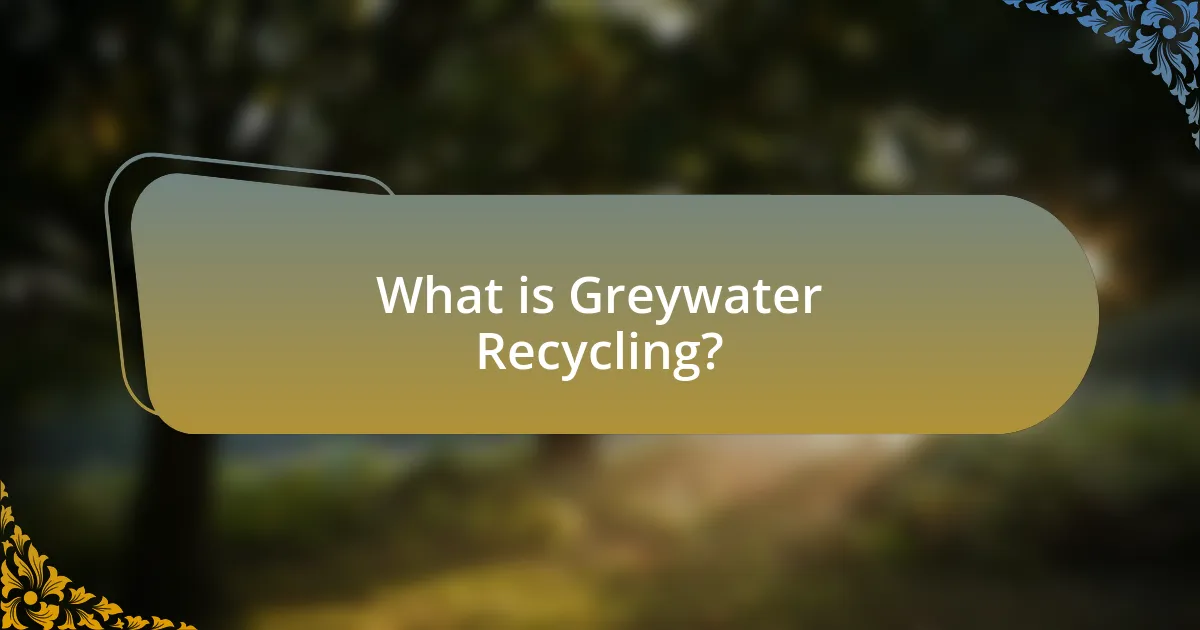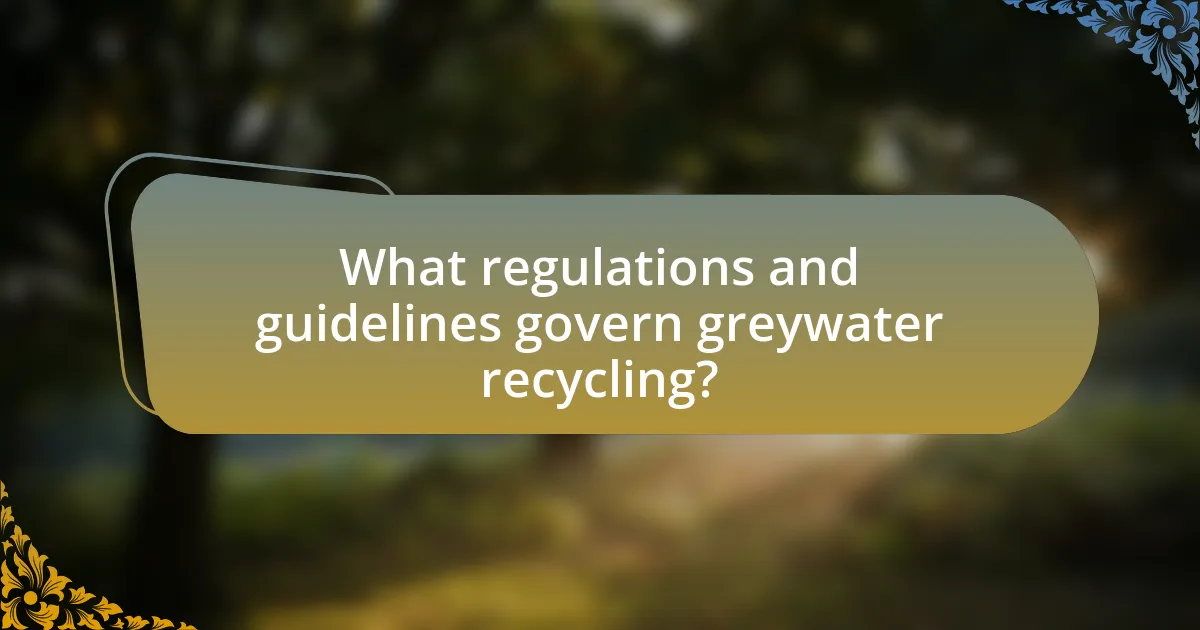Greywater recycling refers to the process of collecting and treating wastewater from household activities, such as bathing, laundry, and dishwashing, for reuse in non-potable applications like irrigation and toilet flushing. This practice can significantly conserve water resources, reduce utility costs, and alleviate pressure on sewage systems, with the potential to save households up to 50% of their water usage. The article explores the definition of greywater, its environmental benefits, common recycling methods, practical applications for households, and the necessary regulations and guidelines for safe implementation. Additionally, it addresses challenges, misconceptions, and best practices for optimizing greywater recycling systems, providing a comprehensive overview of this sustainable water management strategy.

What is Greywater Recycling?
Greywater recycling is the process of collecting and treating wastewater from household activities, such as bathing, laundry, and dishwashing, for reuse in non-potable applications like irrigation and toilet flushing. This practice conserves water resources and reduces the demand on sewage systems, contributing to sustainable water management. According to the U.S. Environmental Protection Agency, greywater can account for up to 50-80% of residential wastewater, highlighting its potential for recycling and reuse in everyday household applications.
How is greywater defined in the context of recycling?
Greywater is defined in the context of recycling as the relatively clean wastewater generated from domestic activities such as washing dishes, laundry, and bathing, excluding toilet waste. This definition is crucial because greywater can be treated and reused for non-potable purposes, such as irrigation and toilet flushing, thereby conserving freshwater resources and reducing wastewater discharge. Studies indicate that greywater recycling can significantly decrease household water consumption, with potential savings of up to 50% in water usage, making it an effective strategy for sustainable water management.
What types of water are considered greywater?
Greywater is defined as wastewater generated from domestic activities excluding toilet waste. The types of water considered greywater include water from sinks, showers, bathtubs, washing machines, and dishwashers. This classification is supported by the fact that greywater typically contains fewer pathogens and contaminants compared to blackwater, which is wastewater from toilets.
What distinguishes greywater from other types of wastewater?
Greywater is distinguished from other types of wastewater by its source and composition; it primarily originates from domestic activities such as bathing, laundry, and dishwashing, and typically contains fewer contaminants than blackwater, which comes from toilets. This lower level of pollutants makes greywater more suitable for recycling and reuse in applications like irrigation and toilet flushing, as it poses a reduced risk to human health and the environment compared to other wastewater types.
Why is greywater recycling important for households?
Greywater recycling is important for households because it conserves water resources and reduces utility costs. By reusing water from sinks, showers, and washing machines, households can decrease their overall water consumption by up to 50%, as reported by the U.S. Environmental Protection Agency. This practice not only alleviates pressure on local water supplies but also minimizes the environmental impact associated with wastewater treatment. Additionally, greywater recycling systems can lead to significant savings on water bills, making them economically beneficial for families.
What environmental benefits does greywater recycling provide?
Greywater recycling provides significant environmental benefits, including water conservation, reduced wastewater generation, and decreased demand on freshwater resources. By reusing water from sinks, showers, and laundry, households can save up to 50% of their water usage, which alleviates pressure on local water supplies. Additionally, greywater recycling minimizes the volume of wastewater entering treatment facilities, thereby reducing energy consumption and pollution associated with wastewater treatment processes. Studies indicate that implementing greywater systems can lead to a reduction of up to 30% in overall household water use, contributing to sustainable water management practices.
How does greywater recycling contribute to water conservation?
Greywater recycling significantly contributes to water conservation by reusing water from household activities such as bathing, laundry, and dishwashing for non-potable purposes like irrigation and toilet flushing. This process reduces the demand for freshwater sources, which is critical as global water scarcity affects billions of people. According to the U.S. Environmental Protection Agency, recycling greywater can save an average household up to 40% of its water usage, thereby alleviating pressure on municipal water systems and promoting sustainable water management practices.
What are the common methods of greywater recycling?
Common methods of greywater recycling include filtration, biological treatment, and disinfection. Filtration systems remove larger particles and debris from greywater, making it suitable for irrigation and toilet flushing. Biological treatment utilizes microorganisms to break down organic matter, enhancing water quality for reuse. Disinfection methods, such as chlorination or UV treatment, eliminate pathogens, ensuring the recycled greywater is safe for non-potable applications. These methods are widely adopted in residential settings to conserve water and reduce environmental impact.
How do simple greywater systems work?
Simple greywater systems work by collecting wastewater from household sources like sinks, showers, and washing machines, and redirecting it for reuse in irrigation or toilet flushing. These systems typically involve a series of pipes that transport the greywater to a storage tank or treatment unit, where it may undergo basic filtration to remove larger particles. The treated greywater is then distributed to designated areas, such as gardens or toilets, reducing the demand for fresh water. According to the U.S. Environmental Protection Agency, greywater recycling can save households up to 50% of their water usage, demonstrating the efficiency and practicality of these systems in promoting sustainable water management.
What are the differences between passive and active greywater systems?
Passive greywater systems rely on gravity and natural processes to treat and disperse greywater, while active greywater systems use mechanical components, such as pumps and filters, to facilitate treatment and distribution. Passive systems typically involve simple designs like mulch basins or constructed wetlands, which require minimal maintenance and energy input. In contrast, active systems often involve more complex setups, including treatment tanks and automated controls, which can provide more efficient treatment but require regular maintenance and energy consumption. The choice between these systems often depends on factors such as site conditions, budget, and desired treatment levels.

What practical applications exist for households using greywater recycling?
Households can use greywater recycling for irrigation, toilet flushing, and laundry. Specifically, greywater from sinks, showers, and washing machines can be treated and reused for watering gardens, which conserves potable water and reduces water bills. Additionally, using greywater for toilet flushing can save significant amounts of water; studies indicate that toilets account for nearly 30% of residential water use. Furthermore, greywater can be utilized in laundry systems designed for such purposes, promoting water efficiency. These applications not only enhance water conservation efforts but also contribute to sustainable household practices.
How can households implement greywater recycling systems?
Households can implement greywater recycling systems by installing a greywater collection and treatment system that captures water from sinks, showers, and washing machines for reuse in irrigation or toilet flushing. This process typically involves setting up a filtration system to remove contaminants, followed by a storage tank to hold the treated greywater until needed. According to the U.S. Environmental Protection Agency, greywater recycling can reduce water usage by up to 50%, making it an effective method for conserving water resources.
What are the steps to install a greywater recycling system?
To install a greywater recycling system, follow these steps: First, assess your household’s greywater sources, such as sinks, showers, and washing machines, to determine the volume and type of greywater available for reuse. Next, select an appropriate greywater system that meets local regulations and your household needs, which may include a simple diversion system or a more complex treatment system. After selecting the system, obtain necessary permits from local authorities to ensure compliance with building codes. Then, install the system by connecting the greywater sources to the treatment unit or storage tank, ensuring proper filtration and disinfection methods are in place. Finally, connect the treated greywater to irrigation systems or other reuse applications, and conduct regular maintenance checks to ensure the system operates efficiently. These steps are essential for effective greywater recycling, which can reduce water consumption and promote sustainable practices in households.
What maintenance is required for greywater systems?
Greywater systems require regular maintenance to ensure proper function and prevent issues. This includes routine inspections of the system components, such as filters and pumps, to check for clogs or wear. Additionally, the greywater should be treated with appropriate chemicals to prevent bacterial growth and odors. Regular cleaning of the storage tank and monitoring of water quality are also essential to maintain system efficiency. According to the U.S. Environmental Protection Agency, proper maintenance can extend the lifespan of greywater systems and enhance their effectiveness in recycling water for household use.
What are the potential uses of recycled greywater in households?
Recycled greywater in households can be used for irrigation, toilet flushing, and laundry. Specifically, greywater from sinks, showers, and washing machines can be redirected for landscape irrigation, which conserves potable water and promotes plant health. According to the U.S. Environmental Protection Agency, using greywater for irrigation can reduce household water use by up to 50%. Additionally, greywater can be utilized in toilet flushing systems, significantly decreasing the demand for clean water in sanitation. Furthermore, it can be employed in laundry applications, allowing for the reuse of water that has already been used for washing. These applications not only enhance water conservation efforts but also contribute to sustainable household practices.
How can greywater be used for irrigation purposes?
Greywater can be used for irrigation purposes by collecting wastewater from sinks, showers, and washing machines, treating it to remove contaminants, and then applying it to gardens or landscapes. This practice conserves freshwater resources and reduces the volume of wastewater entering sewage systems. Studies indicate that properly treated greywater can safely irrigate non-edible plants and some edible crops, provided it meets health and safety standards, such as those outlined by the U.S. Environmental Protection Agency, which recommends specific treatment methods to minimize pathogens and pollutants.
What are the considerations for using greywater in toilet flushing?
Using greywater for toilet flushing requires careful consideration of health, plumbing, and regulatory factors. Health considerations include the potential presence of pathogens and contaminants in greywater, which can pose risks if not properly treated. Plumbing systems must be designed to separate greywater from potable water to prevent cross-contamination, and appropriate filtration and treatment methods should be employed to ensure water quality. Regulatory considerations involve compliance with local laws and guidelines governing greywater use, which can vary significantly by region. For instance, the U.S. Environmental Protection Agency provides guidelines that emphasize the need for safe handling and treatment of greywater to protect public health and the environment.
What challenges do households face with greywater recycling?
Households face several challenges with greywater recycling, primarily concerning health risks, regulatory issues, and system complexity. Health risks arise from potential contamination of greywater, which can harbor pathogens if not properly treated. Regulatory issues often include strict local laws that may limit or prohibit greywater reuse, complicating implementation. Additionally, the complexity of installing and maintaining greywater systems can deter households, as these systems require technical knowledge and ongoing upkeep to function effectively.
What are the common misconceptions about greywater recycling?
Common misconceptions about greywater recycling include the belief that it is unsafe for human health, that it requires complex systems, and that it is only suitable for outdoor use. Many people think greywater, which is wastewater from sinks, showers, and washing machines, poses health risks; however, studies show that properly treated greywater can be safe for irrigation and toilet flushing. Additionally, while some greywater systems can be intricate, many simple and cost-effective options exist for households. Lastly, greywater can be reused indoors, such as for toilet flushing, not just for outdoor irrigation, expanding its practical applications in households.
How can households address health and safety concerns related to greywater?
Households can address health and safety concerns related to greywater by implementing proper treatment systems and adhering to local regulations. Installing a greywater treatment system, such as a sand filter or a constructed wetland, can effectively reduce pathogens and contaminants, making the water safer for reuse. According to the U.S. Environmental Protection Agency, treated greywater can be used for irrigation and toilet flushing, minimizing health risks when managed correctly. Additionally, households should regularly monitor and maintain their greywater systems to ensure they function effectively and comply with health standards, thereby reducing the potential for contamination and associated health issues.

What regulations and guidelines govern greywater recycling?
Regulations and guidelines governing greywater recycling vary by region but generally include health and safety standards, water quality criteria, and system design specifications. In the United States, the Environmental Protection Agency (EPA) provides guidelines that recommend treating greywater to meet specific quality standards before reuse, while many states have their own regulations that dictate the permissible uses of greywater, such as irrigation or toilet flushing. For instance, California’s Title 22 regulations outline treatment processes and system requirements for greywater systems, ensuring public health protection. These regulations are essential for ensuring that greywater recycling is safe and effective, promoting sustainable water use while minimizing health risks.
What legal considerations should households be aware of?
Households should be aware that greywater recycling is subject to specific legal regulations that vary by jurisdiction. These regulations often include guidelines on the types of greywater that can be reused, the methods of treatment required, and the permissible uses of recycled greywater, such as irrigation or toilet flushing. For instance, in California, the Department of Water Resources mandates that greywater systems must comply with local building codes and health regulations to ensure public safety and environmental protection. Failure to adhere to these legal requirements can result in fines or the dismantling of non-compliant systems.
How do local regulations vary regarding greywater use?
Local regulations regarding greywater use vary significantly across different jurisdictions. In some areas, regulations may permit the use of greywater for irrigation and toilet flushing, while others may restrict its use due to health and safety concerns. For instance, California allows greywater systems under specific guidelines, requiring permits and adherence to plumbing codes, whereas states like Florida have more stringent regulations that limit greywater use to certain applications and require advanced treatment systems. These variations are influenced by local water scarcity issues, public health policies, and environmental considerations, reflecting the diverse approaches to managing water resources effectively.
What guidelines should be followed to ensure safe greywater recycling?
To ensure safe greywater recycling, it is essential to follow guidelines that include proper treatment, appropriate use, and adherence to local regulations. Proper treatment involves filtering and disinfecting greywater to remove contaminants, which can be achieved through methods such as sedimentation, filtration, and chemical disinfection. Appropriate use means applying treated greywater for non-potable purposes, such as irrigation or toilet flushing, while avoiding direct contact with edible plants. Adherence to local regulations is crucial, as many regions have specific laws governing greywater systems to ensure public health and environmental safety. These guidelines are supported by studies indicating that untreated greywater can harbor pathogens, making treatment and regulation vital for safe recycling practices.
How can households ensure compliance with greywater recycling standards?
Households can ensure compliance with greywater recycling standards by following local regulations and guidelines set by environmental authorities. This includes obtaining necessary permits, using approved greywater treatment systems, and adhering to specific design and operational requirements outlined in the regulations. For instance, the U.S. Environmental Protection Agency (EPA) provides guidelines that specify the types of greywater that can be reused, such as water from sinks and showers, while prohibiting the use of water from toilets. Additionally, households should regularly maintain their greywater systems to ensure they function correctly and meet health and safety standards, thereby reducing the risk of contamination and ensuring compliance.
What resources are available for understanding greywater regulations?
Resources for understanding greywater regulations include government websites, local health departments, and environmental organizations. Government websites often provide comprehensive guidelines and legal frameworks regarding greywater use, such as the U.S. Environmental Protection Agency (EPA) which outlines federal regulations. Local health departments typically offer region-specific regulations and permits necessary for greywater systems. Additionally, organizations like the Greywater Action provide educational materials and resources that explain the legal aspects and best practices for greywater recycling. These resources collectively ensure that individuals and households can navigate the complexities of greywater regulations effectively.
How can households stay updated on changes in greywater policies?
Households can stay updated on changes in greywater policies by regularly checking local government websites and subscribing to newsletters from environmental agencies. Local governments often publish updates on regulations and guidelines regarding greywater use, which can be found on their official websites. Additionally, organizations such as the Environmental Protection Agency (EPA) provide resources and updates on water conservation practices, including greywater policies. Engaging with community forums and attending local meetings can also provide insights into any upcoming changes or discussions regarding greywater regulations.
What are the best practices for successful greywater recycling?
The best practices for successful greywater recycling include proper source separation, appropriate treatment methods, and adherence to local regulations. Proper source separation involves collecting greywater from sinks, showers, and laundry while avoiding contamination from toilets. Appropriate treatment methods, such as filtration and biological treatment, ensure that the greywater is safe for reuse in irrigation or toilet flushing. Adhering to local regulations is crucial, as many regions have specific guidelines regarding greywater use to protect public health and the environment. Implementing these practices can enhance the efficiency and safety of greywater recycling systems.
How can households optimize their greywater recycling systems for efficiency?
Households can optimize their greywater recycling systems for efficiency by implementing a multi-stage filtration process, which ensures the removal of contaminants and enhances water quality. This approach typically involves using a combination of sediment filters, activated carbon filters, and UV sterilization, which collectively improve the safety and usability of recycled greywater. Research indicates that systems employing these filtration methods can reduce pathogens by up to 99.9%, making the recycled water suitable for irrigation and toilet flushing. Additionally, households should regularly maintain and monitor their systems to prevent clogs and ensure optimal performance, as consistent upkeep can increase the lifespan and efficiency of greywater recycling systems.
What tips can help households troubleshoot common greywater issues?
To troubleshoot common greywater issues, households should first identify the source of the problem, such as clogs or odors. Regularly inspecting and cleaning filters and pipes can prevent blockages, while ensuring proper ventilation can mitigate unpleasant smells. Additionally, households should monitor the pH levels of greywater, as imbalances can lead to plant damage; maintaining a pH between 6.5 and 7.5 is ideal for most plants. Implementing these practices can enhance the efficiency of greywater systems and promote healthier reuse.


